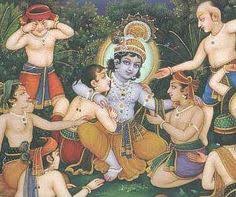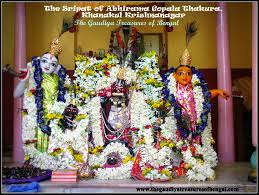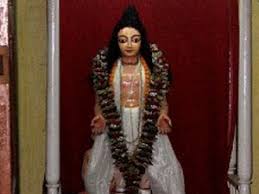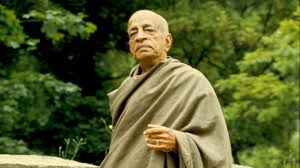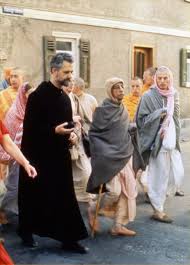Tuesday, April 14, 2020
Monday, April 13, 2020
→ The Walking Monk
Sunday, April 12, 2020
→ The Walking Monk
Saturday, April 11, 2020
→ The Walking Monk
H.H. Radhanath Swami Speaks About the #GivingTOVP 10 Day Matching Fundraiser
- TOVP.org
Recently we sent out the official announcement about the Second Annual #GivingTOVP 10 Day Matching Fundraiser which you can read here. This event starts on April 26 (Akshaya Tritiya) until May 6 (Nrsimha Caturdasi) and is poised to raise over $300,000 to help the completion of Lord Nrsimha’s entire East Wing and altar in the TOVP for the opening ceremony during Gaur Purnima 2021.
In this video His Holiness Radhanath Swami speaks about the importance of this fundraiser for completing Lord Nrsimha’s temple wing and altar by 2021.
SPECIAL ANNOUNCEMENT
Due to the disastrous effects of the Corona virus pandemic worldwide and the 21 day lock-down in India, ISKCON Mayapur is experiencing a serious financial crisis. On account of this emergency situation, Ambarisa and Braja Vilasa prabhus from the TOVP have decided to help ISKCON Mayapur by creating an extension campaign to the #GivingTOVP Fundraiser called the TOVP Care Emergency Matching Fund Campaign. Ambarisa will match 10 cents for every dollar raised for the #GivingTOVP Fundraiser (online only) and donate it to ISKCON Mayapur.
For more information go here.
Please download and share the #GivingTOVP Fundraiser flyer below.

TOVP NEWS AND UPDATES – STAY IN TOUCH
Visit us at: www.tovp.org
Follow us at: www.facebook.com/tovp.mayapur
Watch us at: www.youtube.com/user/tovpinfo
View us 360° at: www.tovp360.org
App at: https://m.tovp.org/app
News & Texts at: https://m.tovp.org/newstexts
RSS News Feed at: https://tovp.org/rss2/
Buy from us at: https://tovp.org/tovp-gift-store/
Support us at: https://tovp.org/donate/seva-opportunities/
The post H.H. Radhanath Swami Speaks About the #GivingTOVP 10 Day Matching Fundraiser appeared first on Temple of the Vedic Planetarium.
When Lord Chaitanya destroys demonic mentality, not demons, why did the person who threatened devotees constructing the Juhu temple die?
→ The Spiritual Scientist
Answer Podcast
The post When Lord Chaitanya destroys demonic mentality, not demons, why did the person who threatened devotees constructing the Juhu temple die? appeared first on The Spiritual Scientist.
FACING POSSIBLE DISEASE OR DEATH, WHAT IS YOUR URGENT NECESSITY THAT CALLS YOU TO ACT, AND NOT BE AFRAID?
→ Karnamrita's blog
As some of you know I have mainly been recycling older blogs and slightly modifying them to represent some of my current struggles in my treatment protocols. With this offering I am writing afresh, having to discontinue my treatment due to the lockdown here in Vrindavana, though I present similar themes to what I teach as a result of facing possible death for the last 4 ½ years as well as intense headaches and other pains for the last year. I still consider personal or horizontal growth work important for those contemplating the shortness of their life which includes getting our inner (emotional/mental) and outer (physical) house in order.
Why? The simple reason, according to my understanding from personal experience, is that the trauma, disappointment, wounds, and pain from this life and previous lives negatively impacts our practice of bhakti by taking energy away from our focus on loving devotional service and tends to cause us to make offenses to others by our reacting to them based on our past emotional pain and trauma. Progressive spiritual life, and even a successful material life, requires changing unthinking patterns of behavior that don’t serve us or anyone else.
Part of progressive endeavor comes through intense, threadbare introspection, to let us understand our negative patterns or habits of thinking and acting. There are many processes that can assist us in such work and help us be more focused and present spiritually, which is the greatest necessity. We are advised to accept whatever is favorable for our bhakti and give up what isn’t, and that can open up possibilities we might not have considered before.
FACING POSSIBLE DISEASE OR DEATH, WHAT IS YOUR URGENT NECESSITY THAT CALLS YOU TO ACT, AND NOT BE AFRAID?
→ Karnamrita's blog

As some of you know I have mainly been recycling older blogs and slightly modifying them to represent some of my current struggles in my treatment protocols. With this offering I am writing afresh, having to discontinue my treatment due to the lockdown here in Vrindavana, though I present similar themes to what I teach as a result of facing possible death for the last 4 ½ years as well as intense headaches and other pains for the last year. I still consider personal or horizontal growth work important for those contemplating the shortness of their life which includes getting our inner (emotional/mental) and outer (physical) house in order.
Why? The simple reason, according to my understanding from personal experience, is that the trauma, disappointment, wounds, and pain from this life and previous lives negatively impacts our practice of bhakti by taking energy away from our focus on loving devotional service and tends to cause us to make offenses to others by our reacting to them based on our past emotional pain and trauma. Progressive spiritual life, and even a successful material life, requires changing unthinking patterns of behavior that don’t serve us or anyone else.
Part of progressive endeavor comes through intense, threadbare introspection, to let us understand our negative patterns or habits of thinking and acting. There are many processes that can assist us in such work and help us be more focused and present spiritually, which is the greatest necessity. We are advised to accept whatever is favorable for our bhakti and give up what isn’t, and that can open up possibilities we might not have considered before.
H.H. Bhakti Caru Swami Speaks About the #GivingTOVP 10 Day Matching Fundraiser
- TOVP.org
Recently we sent out the official announcement about the Second Annual #GivingTOVP 10 Day Matching Fundraiser which you can read here. This event starts on April 26 (Akshaya Tritiya) until May 6 (Nrsimha Caturdasi) and is poised to raise over $300,000 to help the completion of Lord Nrsimha’s entire East Wing and altar in the TOVP for the opening ceremony during Gaur Purnima 2021.
In this video His Holiness Bhakti Caru Swami speaks about the importance of this fundraiser for completing Lord Nrsimha’s temple wing and altar by 2021.
SPECIAL ANNOUNCEMENT
Due to the disastrous effects of the Corona virus pandemic worldwide and the 21 day lock-down in India, ISKCON Mayapur is experiencing a serious financial crisis. On account of this emergency situation, Ambarisa and Braja Vilasa prabhus from the TOVP have decided to help ISKCON Mayapur by creating an extension campaign to the #GivingTOVP Fundraiser called the TOVP Care Emergency Matching Fund Campaign. Ambarisa will match 10 cents for every dollar raised for the #GivingTOVP Fundraiser (online only) and donate it to ISKCON Mayapur.
For more information go here.
Please download and share the #GivingTOVP Fundraiser flyer below.

TOVP NEWS AND UPDATES – STAY IN TOUCH
Visit us at: www.tovp.org
Follow us at: www.facebook.com/tovp.mayapur
Watch us at: www.youtube.com/user/tovpinfo
View us 360° at: www.tovp360.org
App at: https://m.tovp.org/app
News & Texts at: https://m.tovp.org/newstexts
RSS News Feed at: https://tovp.org/rss2/
Buy from us at: https://tovp.org/tovp-gift-store/
Support us at: https://tovp.org/donate/seva-opportunities/
The post H.H. Bhakti Caru Swami Speaks About the #GivingTOVP 10 Day Matching Fundraiser appeared first on Temple of the Vedic Planetarium.
Gita key verses course 16 – If God is good why does he allow evil to exist?
→ The Spiritual Scientist
Podcast
Video:
The post Gita key verses course 16 – If God is good why does he allow evil to exist? appeared first on The Spiritual Scientist.
Abhirama Thakur Disappearance
→ Ramai Swami
Sri Abhirama Gopal Thakura was also known as Sri Rama Das. He was a great Devotee of Lord Nityananda. On the order of Nityananda Prabhu, he became a great acharya and preacher of Gaudiya Vaishnavism.
He was a very influential personality, and atheists and blasphemers were very much afraid of him. Empowered by Nityananda Prabhu, he was always in ecstasy and was kind to all fallen souls. It is said that if he offered obeisances to any stone other than a shalagram-shila, it would immediately burst into pieces.
According to Gaura-Ganodesa-Dipika (12) in Krishna-lila he was Sridama, one of the 12 prominent boy cowherd friends of Sri Krishna. He was Nityananda’s dear-most devotee. Abhirama Gopal’s wife’s name was Malini devi.
Abhirama Thakura had a bullwhip that was imbued with divine power. Its name was “Jayamangal.” Whoever was struck with this whip became filled with Krishna Prema.
One day Srinivasa Acharya went to take darshan of Abhirama Gopala. At that time, Abhirama Gopal touched him three times with Jayamangal. The Thakur’s good wife, Malini, cried out, “My Lord! Do not touch him again. Calm yourself. Srinivas is only a boy. If you touch him again he will lose consciousness.” As a result of coming in contact with the whip of Abhirama Thakura, Srinivasa Acharya became filled with Sri Krishna Prema.
When Sri Caitanya Mahaprabhu ordered Nityananda Prabhu to preach in Bengal, he sent Abhirama Gopal and Gadadhara Das along with him. His disappearance day is on the seventh day of the dark moon in the month of Chaitra, and on that day a great festival attended by thousands of devotees is held every year in Khanakula-Krishnanagara.
Food For All UK Distributing 4,100 Meals Daily, Expects to Increase to 20,000
→ ISKCON News: Latest Stories

With the UK now about to go into its fourth week of lockdown, people who would be struggling from one week to the next during normal times are now running out of money. Many are also sick or completely isolated in their homes without any family members. In this environment, more and more community groups are calling for free meals to help those in need.
TOVP Architecture Department Report Architecture at the Moment – April 2020
- TOVP.org
The Lives Inside Our Head
It gives me great pleasure to introduce the stars working in the capacity of Architects and Designers who institute the Architecture office in Pune and Mayapur.
The Corona virus put the world on standstill, and Pune still worse. No meetings, no travels, no outdoor movements. This is no impediment for the TOVP Architects, as they find ways and means to remain connected and working virtually.
This report captures snippets of weekly works undertaken by each individual member.
Click here to see it in your browser or download a copy to your desktop for offline reading.
The post TOVP Architecture Department Report Architecture at the Moment – April 2020 appeared first on Temple of the Vedic Planetarium.
Food For Life Hungary Distributes Prasadam and Face Masks to the Needy
→ ISKCON News: Latest Stories
Krishna Consciousness Is the Vaccine for all the Diseases
Giriraj Swami
 Srila Prabhupada’s Letter to Dr. W. H. Wolf-Rottkay, June 18, 1975:
Srila Prabhupada’s Letter to Dr. W. H. Wolf-Rottkay, June 18, 1975:
Biological evolution is taking place on account of the soul’s desire. It takes place because of infection. If a man has smallpox virus, then he is subjected to smallpox. It is not that everyone is infected and everyone is attacked with smallpox disease. Only the person who is infected, he is attacked.
In this connection, Krishna says in the Bhagavad-gita, purusah prakrti-stho hi bhunkte prakrti-jan gunan karanam guna sango ’sya sad-asad-yoni-janmasu [Gita 13.22]. Purusa means the living entity, or the soul. He is subjected to be infected by the modes of material nature. There are three modes of material nature: sattva-guna, raja-guna, tama-guna. And when they are mixed up, they become 3 x 3 = 9, and 9 x 9 = 81, and in each quality, there are millions of forms. Therefore the total number of forms is 8,400,000.
So, the diseases are there, and the forms of disease are also there. Material form means diseased form. Therefore, one has to change this form—death. And he carries with him the infection, and he develops another disease. In this way, the soul, although part and parcel of God, in diseased condition is forced to change body. That is transmigration of the soul from one body to another.
To be more clear, the disease is there. Just as the smallpox disease is there. One has to become diseased, being infected. Similarly, the forms of the body are there. One has been infected by the form and it develops. Karanam guna sango ’sya sad-asad-yoni-janmasu. Because he is infected by different diseased forms, therefore he is developing different forms of body. There is no such case of smallpox changing into malaria. Smallpox is smallpox, and malaria is malaria. By the desire of the living entity, he becomes infected with a certain disease or body. Krishna consciousness is the vaccine for all the diseases (different forms of material bodies).
Krishna says,
mam ca yo ’vyabhicarena bhakti-yogena sevate
sa gunan samatityaitan brahma-bhuyaya kalpate
[Gita 14.26]
Brahma-bhuyaya is the immune stage, or Krishna Conscious stage, when one is always fixed in Krishna. When one reaches this perfectional stage he no longer has to accept these different types of diseases, or bodies.
I hope this meets you in good health.
Your ever well-wisher,
A. C. Bhaktivedanta Swami
Gita key verses course 13 Gita 4.11 Why are there so many religious paths Do all paths lead to the same goal
→ The Spiritual Scientist
Podcast
Video:
The post Gita key verses course 13 Gita 4.11 Why are there so many religious paths Do all paths lead to the same goal appeared first on The Spiritual Scientist.
Friday, April 10, 2020
→ The Walking Monk
Thursday, April 9, 2020
→ The Walking Monk
Wednesday, April 8, 2020
→ The Walking Monk
Tuesday, April 7, 2020
→ The Walking Monk
Vyasa-puja & book 2020
→ KKSBlog

Even though the Vyasa-puja festival and Kingsday were cancelled this year, the devotees from the ISKCON Durban temple in South Africa made a humble effort to have a private event for the Vyasa-puja of His Holiness Kadamba Kanana Swami, and simultaneously stream it live to Mayapur TV and Youtube channel. Devotees joined in from all over the world to stream this event live.
Bhakti Caitanya Swami spoke a few words and residing devotees also had the opportunity to share their experiences and offerings to Kadamba Kanana Swami. After the ceremony, Kadamba Kanana Swami thanked everyone, including the devotees who were watching online, and shared his appreciation of all who spoke and made an effort to organize the event.
Maharaj also took this opportunity to share his prayer for those watching and listening, which in light of the recent events around the world particularly, serves as a prayer for all of us.
‘We do not know what the material world will bring us, good or bad, materially speaking. But it changes nothing. Every time that we go through a difficult situation, and in that difficult situation we take shelter of devotional service, of Srila Prabhupada and of Krsna, and it will make us stronger. In the end, we will come out better’.
‘The flow of the mercy of Lord Caitanya is never obstructed, whatever the situation is. We are all in different places in lockdown right now, but we are still together at Srila Prabhupada’s feet and at Krsna’s feet. So at this time, let us take full advantage of this golden opportunity and if we do this, this human form of life will become the perfect pathway to go back to Godhead. And that is my prayer that we all utilise this one birth to go back home to Godhead’.
Vyasa-puja Book
The Vyasa-puja book is available for downloading in PDF, Epub and Kindle formats. Use the links below to download. The book was designed by Sruti Rupa devi dasi and editing was done by Harsarani devi dasi. Ebooks were created by Nama Rupa devi dasi.
Download pdf ebook
Download epub ebook
Download kindle ebook
Looking for Vyasa-puja books from previous years? Go here…
Vyasa-puja Video Address
Watch the Vyasa-puja class on Youtube, or view the video below.
The article " Vyasa-puja & book 2020 " was published on KKSBlog.
TOVP Care Announces a Goodwill Campaign – Daily Nrsimha Yajna for Devotee Protection
- TOVP.org
As Nrsimha Caturdasi is less than a month away, and the dangers of the worldwide Corona virus pandemic hang over everyone’s heads into the foreseeable future (several devotees have unfortunately already passed away from the virus), the TOVP Management has made an important decision to call on Mayapur Nrsimha’s help.
ISKCON Mayapur is the World Headquarters of ISKCON and the TOVP is the future home of our Deities here. It thus behooves us to act for the benefit of all devotees worldwide as gratitude for their support in building this temple and for keeping the samkirtan movement alive by calling on the Lord of the universe in His form of Lord Nrsimha Who gives protection.
Under Ambarisa prabhu’s instruction, this Goodwill Campaign will include a daily Nrsimha yajna for the protection of the worldwide devotee community specifically, and humanity in general. To participate, we request all devotees to send us their names using the email address below, so they may be announced to the Lord during the daily yajna. We will compile this list and send weekly reports by email of our service, and also post the same on the TOVP website.
TOVP NEWS AND UPDATES – STAY IN TOUCH
Visit us at: www.tovp.org
Follow us at: www.facebook.com/tovp.mayapur
Watch us at: www.youtube.com/user/tovpinfo
View us 360° at: www.tovp360.org
App at: https://m.tovp.org/app
News & Texts at: https://m.tovp.org/newstexts
RSS News Feed at: https://tovp.org/rss2/
Buy from us at: https://tovp.org/tovp-gift-store/
Support us at: https://tovp.org/donate/seva-opportunities/
The post TOVP Care Announces a Goodwill Campaign – Daily Nrsimha Yajna for Devotee Protection appeared first on Temple of the Vedic Planetarium.
ISKCON India serves 6 million plates of Prasad
→ Mayapur.com
Since March 22nd India has been under lockdown due to COVID-19 pandemic. While this has affected the entire country, but millions of low-income families, daily wager laborers, migrant workers, in particular, have been hit hard due to the closure of business and industries. You may be glad to know that, despite all the physical and […]
The post ISKCON India serves 6 million plates of Prasad appeared first on Mayapur.com.
H.G. Jananivas Prabhu Speaks About the #GivingTOVP 10 Day Matching Fundraiser
- TOVP.org
Recently we sent out the official announcement about the Second Annual #GivingTOVP 10 Day Matching Fundraiser which you can read here. This event starts on April 26 (Akshaya Tritiya) until May 6 (Nrsimha Caturdasi) and is poised to raise over $300,000 to help the completion of Lord Nrsimha’s entire East Wing and altar in the TOVP for the opening ceremony during Gaur Purnima 2021.
In this video His Grace Jananivas prabhu speaks about the importance of this fundraiser for completing Lord Nrsimha’s temple wing and altar by 2021.
SPECIAL ANNOUNCEMENT
Due to the disastrous effects of the Corona virus pandemic worldwide and the 21 day lock-down in India, ISKCON Mayapur is experiencing a serious financial crisis. On account of this emergency situation, Ambarisa and Braja Vilasa prabhus from the TOVP have decided to help ISKCON Mayapur by creating an extension campaign to the #GivingTOVP Fundraiser called the TOVP Care Emergency Matching Fund Campaign. Ambarisa will match 10 cents for every dollar raised for the #GivingTOVP Fundraiser (online only) and donate it to ISKCON Mayapur.
For more information go here.
Please download and share the #GivingTOVP Fundraiser flyer below.

TOVP NEWS AND UPDATES – STAY IN TOUCH
Visit us at: www.tovp.org
Follow us at: www.facebook.com/tovp.mayapur
Watch us at: www.youtube.com/user/tovpinfo
View us 360° at: www.tovp360.org
App at: https://m.tovp.org/app
News & Texts at: https://m.tovp.org/newstexts
RSS News Feed at: https://tovp.org/rss2/
Buy from us at: https://tovp.org/tovp-gift-store/
Support us at: https://tovp.org/donate/seva-opportunities/
The post H.G. Jananivas Prabhu Speaks About the #GivingTOVP 10 Day Matching Fundraiser appeared first on Temple of the Vedic Planetarium.
Gita key verses course 12 Gita 4.8 Who is God Does he care Why should I care
→ The Spiritual Scientist
Podcast
Video:
The post Gita key verses course 12 Gita 4.8 Who is God Does he care Why should I care appeared first on The Spiritual Scientist.
Srila Prabhupada on Jesus Christ
→ Ramai Swami
As Lord Jesus Christ said, we should hate the sin, not the sinner. That is a very nice statement, because the sinner is under illusion. He is mad. If we hate him, how can we deliver him? Therefore, those who are advanced devotees, who are really servants of God, do not hate anyone.
When Lord Jesus Christ was being crucified, he said, “My God, forgive them. They know not what they do.” This is the proper attitude of an advanced devotee. He understands that the conditioned souls cannot be hated, because they have become mad due to their materialistic way of thinking.
In this Krsna consciousness movement, there is no question of hating anyone. Everyone is welcomed to come and chant Hare Krsna, take Krsna-prasada, listen to the philosophy of Bhagavad-gita, and try to rectify material, conditioned life. This is the essential program of Krsna consciousness.
ISKCON Scarborough – Online multimedia class – Meditation on the form of the Lord – Part 2 – Sunday 12th April 2020 – 11 am to 12 noon
→ ISKCON Scarborough
Please accept our humble obeisances!
All glories to Srila Prabhupada!
All glories to Sri Guru and Sri Gauranga!
We will have an online Sunday feast class tomorrow on 12th April 2020 from 11 am to 12 noon.
Please note that this is a virtual class where you can take part from the comfort of your home.
Topic: Meditation on the form of the Lord - Part 2 (SB 3.28.21 to 33) = 13 verses
Date: 12th April 2020 (Sunday)
Time: 11 am to 12 noon
Link to join the class from your desktop or laptop:
https://us04web.zoom.us/j/9150790510?pwd=Wk5GYXVRMkJmdk84MzZJRXBKYUgwUT09
If you click the above link from your desktop or laptop, you will be able to join directly
If you click this link from your cell phone or IPAD etc, you will have to download the Zoom application (less than a minute to download)
Summary:
Lord Kapila is instructing His mother Devahuti on how one should concentrate and meditate on the form of the Supreme Personality of Godhead.
SB 3.28.11:
By practising the process of prāṇāyāma, one can eradicate the contamination of his physiological condition, and by concentrating the mind one can become free from all sinful activities. By restraining the senses one can free himself from material association, and by meditating on the Supreme Personality of Godhead one can become free from the three modes of material attachment.
ISKCON Scarborough
3500 McNicoll Avenue, Unit #3,
Scarborough, Ontario,
Canada, M1V4C7
Website: www.iskconscarborough.org
Email:
iskconscarborough@hotmail.com
scarboroughiskcon@gmail.com
ISKCON & TOVP Leaders Speak About the #GivingTOVP & TOVP Care 10 Day Matching Fundraiser
- TOVP.org
In the wake of the historic and landmark opening of the 1.5 acre, 69 rooms TOVP Pujari Floor in February, the TOVP Management is now preparing to open the completed Nrsimha temple wing and altar in 2021. For that purpose we are focusing the Second Annual #GivingTOVP 10 Day Matching Fundraiser from April 26 (Akshaya Tritiya) until May 6 (Nrsimha Caturdasi) for this purpose, and Ambarisa prabhu has pledged to match the total collection up to $150,000.
However, due to the recent India lockdown, ISKCON Mayapur is in a financial crisis and our World Headquarters is in need of assistance from one-and-all members of ISKCON. To help with that cause, Ambarisa and Braja Vilasa prabhus have added an extension campaign to the #GivingTOVP fundraiser called the TOVP Care Emergency Fundraising Campaign in which 10 cents from every dollar donated online will go directly to ISKCON Mayapur. Read more about that here.
The interviews of ISKCON leaders were made prior to the addition of the TOVP Care Campaign, but the importance of both projects cannot be overemphasized. Despite the world situation due to the worldwide Corona virus pandemic, ISKCON and the TOVP must continue at all costs and your one donation will help this combined effort.
To make a donation to the #GivingTOVP & TOVP Care Campaign go here.
Please download the #GivingTOVP & TOVP Care Flyer and spread the word.

TOVP NEWS AND UPDATES – STAY IN TOUCH
Visit us at: www.tovp.org
Follow us at: www.facebook.com/tovp.mayapur
Watch us at: www.youtube.com/user/tovpinfo
View us 360° at: www.tovp360.org
App at: https://m.tovp.org/app
News & Texts at: https://m.tovp.org/newstexts
RSS News Feed at: https://tovp.org/rss2/
Buy from us at: https://tovp.org/tovp-gift-store/
Support us at: https://tovp.org/donate/seva-opportunities/
The post ISKCON & TOVP Leaders Speak About the #GivingTOVP & TOVP Care 10 Day Matching Fundraiser appeared first on Temple of the Vedic Planetarium.
Gita key verses course 11 Gita 4.1-2 What is revelation Is it for real
→ The Spiritual Scientist
Podcast
Video:
The post Gita key verses course 11 Gita 4.1-2 What is revelation Is it for real appeared first on The Spiritual Scientist.
Monday, April 6th, 2020
→ The Walking Monk
Sunday, April 5th, 2020
→ The Walking Monk
Worship Lord Gauranga, Chant Gauranga – Madhavas Rock Band
→ ISKCON News: Latest Stories
We All Have The Opportunity To Save Lives
→ ISKCON News: Latest Stories
Kovida Compass
→ ISKCON News: Latest Stories

The word “kovida” appears in a celebrated verse from the Bhagavata-Purana: “Those who are intelligent and philosophically inclined (kovida) should endeavour for that which is beyond the material world." Let the mantra become part of you: adjust your expectation, accept your situation, and aspire for connection.
Bhaktivedanta Institute Gainesville Launches “Mapping Post-materialism” Project
→ ISKCON News: Latest Stories
ISKCON Mayapur: Life Under Lockdown
→ ISKCON News: Latest Stories
Argentina: Prasadam Distribution to Police Officers
→ ISKCON News: Latest Stories
HARE KRISHNA! Movie: Free Viewing This Weekend
→ ISKCON News: Latest Stories
HH Gopal Krishna Maharaja Speaks About the #GivingTOVP 10 Day Matching Fundraiser
- TOVP.org
Recently we sent out the official announcement about the Second Annual #GivingTOVP 10 Day Matching Fundraiser which you can read here. This event starts on April 26 (Akshaya Tritiya) until May 6 (Nrsimha Caturdasi) and is poised to raise over $300,000 to help the completion of Lord Nrsimha’s entire East Wing and altar in the TOVP for the opening ceremony during Gaur Purnima 2021.
In this video His Holiness Gopal Krishna Maharaja speaks about the importance of this fundraiser for completing Lord Nrsimha’s temple wing and altar by 2021.
SPECIAL ANNOUNCEMENT
Due to the disastrous effects of the Corona virus pandemic worldwide and the 21 day lock-down in India, ISKCON Mayapur is experiencing a serious financial crisis. On account of this emergency situation, Ambarisa and Braja Vilasa prabhus from the TOVP have decided to help ISKCON Mayapur by creating an extension campaign to the #GivingTOVP Fundraiser called the TOVP Care Emergency Matching Fund Campaign. Ambarisa will match 10 cents for every dollar raised for the #GivingTOVP Fundraiser (online only) and donate it to ISKCON Mayapur.
For more information go here.
Please download and share the #GivingTOVP Fundraiser flyer below.

TOVP NEWS AND UPDATES – STAY IN TOUCH
Visit us at: www.tovp.org
Follow us at: www.facebook.com/tovp.mayapur
Watch us at: www.youtube.com/user/tovpinfo
View us 360° at: www.tovp360.org
App at: https://m.tovp.org/app
News & Texts at: https://m.tovp.org/newstexts
RSS News Feed at: https://tovp.org/rss2/
Buy from us at: https://tovp.org/tovp-gift-store/
Support us at: https://tovp.org/donate/seva-opportunities/
The post HH Gopal Krishna Maharaja Speaks About the #GivingTOVP 10 Day Matching Fundraiser appeared first on Temple of the Vedic Planetarium.
New Vrindaban Scales Down to Core Personnel, Appeals to Devotees to Follow COVID-19 Guidelines
→ ISKCON News: Latest Stories

New Vrindaban has 2,200 acres, has been established as a foremost place of pilgrimage in North America, and welcomes 35,000 visitors per year. With a stay-at-home order issued in West Virginia, ISKCON New Vrindaban has closed down Prabhupada’s Palace, the Palace Lodge, and Govinda’s restaurant, losing half its income in the process.




